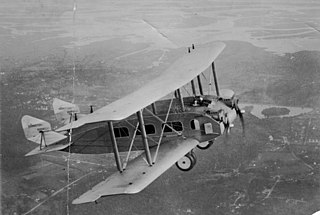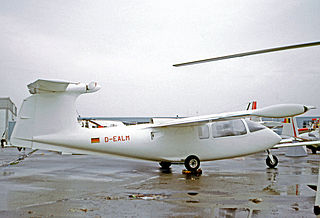Notes
Related Research Articles

The British Aerospace Jetstream 41 is a turboprop-powered feederliner and regional airliner, designed by British Aerospace as a stretched version of the popular Jetstream 31. Intended to compete directly with 30-seat aircraft like the Embraer Brasilia, Dornier 328 and Saab 340, the new design eventually accommodated 29 passengers in a two-by-one arrangement like the Jetstream 31. Eastern Airways of the UK is the biggest operator of Jetstream 41s in the world, with 14 in the fleet.

The CAP Aviation CAP-23x family is a family of aircraft designed for competition aerobatics. The CAP 230 airframe was a direct development of the CAP 21 competition single seater strengthened to cope with a 300 hp (220 kW) 6-cylinder Lycoming AEIO-540 engine instead of the 200 hp (150 kW) original 4-cylinder Lycoming AEIO-360.

The Sukhoi Su-29 is a Russian two-seat aerobatic aircraft with a 268 kW (360 hp) radial engine. It was designed based on the Su-26 and inherited most of the design and technical features of its predecessor. Due to wide use of composite materials, which make up as much as 60% of the Su-29's aircraft structure, the empty weight is increased by only 50 kg (110 lb) over the single-seat Su-26's empty weight.

The ASH 26 is an 18 metre Class glider, built of modern fibre reinforced composites. It first flew in 1993. It is manufactured by Alexander Schleicher GmbH & Co. The 'H' indicates this is a design of Martin Heide.

The Gavilán 358 is a Colombian light utility transport aircraft of the 1990s. A high-winged monoplane powered by a piston engine, small numbers of Gaviláns were produced in the late 1990s/early 2000s, some serving with the Colombian Air Force.

The PZL-105 Flaming (flamingo) is a Polish short-takeoff-and-landing (STOL) utility aircraft designed by PZL "Warszawa-Okęcie". It remained a prototype.

The Grob GF 200 was a business aircraft of unorthodox design developed in Germany during the 1990s.

The Malmö MFI-10 Vipan was a four-seat light utility monoplane designed and built in Sweden by Malmö Flygindustri. Only three aircraft were built and the type did not enter quantity production.

The PZL M-24 Dromader Mini, originally named the Lama, is a single engine agricultural aircraft, developed in the 1980s by WSK-Mielec from the PZL-Mielec M-18 Dromader. The prototype, registration SP-PDM, first flew on 18 June 1982. It did not progress beyond the prototyping stage.

The Burnelli RB-1 was a US twin engine biplane airliner prototype from 1920, incorporating a lifting body fuselage.

The Pöschel Equator was a single engine, 6/8 seat amphibious aircraft built in the 1970s featuring glass-fibre covered fuselage. Three aircraft were built, each with different engine or wing positions, but no production followed.
The Zenair CH 180 Super Acro-Z is an aerobatic light aircraft, that was designed by Chris Heintz and built by Zenair in the 1980s.
The ATR 52 was a project to develop a military transport aircraft and a 50-seat airliner to add to ATR's product range. The manufacturer pursued the project throughout the 1990s, but was never able to attract sufficient interest from customers to make the project viable. Over the course of the decade, the design shifted from being a stretched ATR 42 to a shortened ATR 72.
The Aircorp B2-N Bushmaster is a prototype Australian light aircraft designed for aerobatic, touring, and utility use. It first flew in 1989 and did not enter production.
The Aviones de Colombia AC-05 Pijao is an agricultural aircraft manufactured in Colombia in the 1990s. It was developed to fill a gap in the local market after Cessna discontinued production of the Cessna 188 that Aviones de Colombia had been assembling and supporting. Although the Pijao resembles the Cessna 188 in appearance and role, it was, at least to some degree, a new design. "Pijao" is the name of an indigenous people of Colombia.
The Phönix-Aviatechnica LKhS-4 was a 1990s Russian design for a civil utility aircraft of unusual configuration. Its designation is an acronym of Legkiy Khozyaystvennyy Samolet — "light utility aircraft" in Russian. In addition to general aviation purposes, the LKhS-4's intended use was air-taxi and commuter roles throughout the CIS and it was therefore designed to be able to operate from soft snow or mud.
The Interavia I-1L Leshiy, also produced as the Phönix-Aviatechnica SL-90 Leshiy is a light aircraft first manufactured in Russia in the 1990s. A Leshiy is a type of forest spirit in Russian folklore.
The Mikoyan MiG SVB was a 1990s Russian project to develop a turboprop-powered regional airliner and cargo transport for hot and high environments, including operations at night and in all weather. The SVB was expected to have considerably lower operating costs from similar aircraft already in service, such as the Antonov An-32. These anticipated savings were largely due to the type's newer and lower-power engines, the Klimov TV7-117S.
The Mikoyan MiG 18-50 was a 1990s Russian project to develop an aircraft that could be configured as a regional airliner or as a business jet with intercontinental range. The 18-50 designation reflected these two roles, referring to the 18 seats it would have in business-jet configuration, or its 50 seats as an airliner. Mikoyan did not put the design into production, and by 1993 it was taken up by Aviaprom for further development, first as the Eurasia 18-50 and then evolved into an 8- to 18-seat business jet as the Aviastayer (Авиастайер).
The Eagle Aircraft X-TS, known as the Eagle Aircraft X-Wing in its prototype form and retroactively as the Eagle Aircraft Eagle 100, is an Australian light aircraft developed in the 1980s and manufactured in the 1990s. It has an unconventional tandem wing design and a structure of composite materials. It was marketed for a range of general aviation purposes, including basic training, aerial survey, and cattle mustering. It was replaced in production by the Eagle Aircraft Eagle 150, and some Eagle 100s were remanufactured into this later model. The "TS" in the designation stood for "two-seat", in contrast to Eagle's development aircraft, the EX-P1, which was a single-seater.
References
Bibliography
- "Airscene Headlines". Air International. Vol. 52, no. 8. Stamford, Lincolnshire: Key Publishing. February 1993. pp. 58–64.
- Becker, Dave (August 1990). "The Celair Eagle 300". Air Pictorial. Vol. 52, no. 8. Ascot, Berkshire: Profile Books. p. 288.
- "Celair starts Eagle test program". Flight International. Surrey: Reed Business Publishing. 11–13 June 1990. p. 20.
- "Flugerprobung" [Flight testing]. Flug Revue. No. 8. Stuttgart: Motor Press. 1990. p. 21.
- Lambert, Mark; Munson, Kenneth; Taylor, Michael J.H., eds. (1992). Jane's All the World's Aircraft 1992-93 (83rd ed.). Coulson, Surrey, UK: Jane's Information Group.
- Taylor, Michael J. H. (1993). Jane's Encyclopedia of Aviation. London: Studio Editions.
- Taylor, Michael J.H.; Lambert, Mark; Munson, Kenneth, eds. (1993). Jane's All the World's Aircraft 1993-94 (84th ed.). Coulson, Surrey, UK: Jane's Information Group.